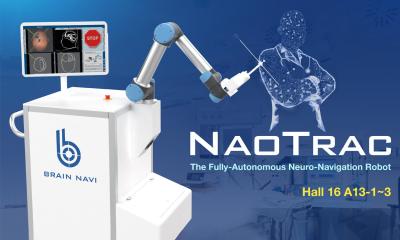
© greenbutterfly – stock.adobe.com
Article • Future treaments discussed at senology congress
How will we treat breast cancer in 2034?
The year: 2034. Breast cancer patients benefit from perfectly personalised diagnostics and therapies. The tedium of follow-up treatments is a thing of the past, thanks to AI, augmented reality and robotics. Just a tale from the realm of science fiction, or could this soon be clinical reality? At the annual meeting of the German Senologic Society, Prof Dr Marc Thill from the Agaplesion Markus Hospital in Frankfurt cast a glance into the crystal ball, exploring the potential of new technologies, but also pointing out bottlenecks in diagnostics and professional personnel.
Article: Wolfgang Behrends
The trend is clearly moving towards further streamlining treatment pathways and de-escalating surgical therapies, the expert noted. ‘Of course, our patients benefit from not having so many appointments and having fewer procedures performed on them.’ For example, a reduced number of pre- and post-treatments minimizes the risk of cosmetically poorer results and surgery-related complications such as infections. Thill is therefore convinced that this goal of streamlining will lead to the outpatientisation of breast cancer treatment – a development that is already well advanced in countries such as UK and Denmark.1
The establishment of non-radioactive tracers for labelling sentinel lymph nodes (SLN), such as indocyanine green (ICG) and super-paramagnetic iron oxide (SPIO), will also contribute to streamlining the processes, the expert predicted. These substances offer a detection rate on par with radiotracers,2,3 but without involvement of nuclear medicine. In the case of ICG, not even a preparation appointment is required to administer the tracer, explained Thill – it is simply given ten minutes before the operation.
Recommended article

Article • Research, diagnostics, treatments
Focus on breast cancer
Breast cancer (breast carcinoma; often abbreviated as BRCA) is the most common cancer in women in many countries and the cancer with the highest mortality rate. The diagnostic and therapeutic options for breast cancer are correspondingly diverse. Keep reading for latest developments in early detection, staging, treatment and research.
In Germany, radioactive markers such as technetium-99m (99mTc) are used for the majority of interventions with SLN labelling.4 However, their availability is by no means guaranteed, the expert remarked – only few reactors produce these markers, and an outage would suffice to cripple the supply.
3D-printing, VR surgeries and more: what does the future hold?
The number of patient appointments can also be reduced by using probe-based marking procedures, skipping the intermediate step of wire or clip localisation. In the future, the treatment pathway could be streamlined even further, Thill predicted: a new procedure from US manufacturer Cairn Surgical uses personalised, 3D-printed breast caps with integrated wire guiding ports, meaning that pre-operative marking can be completely dispensed with.
This is taken even further in approaches based on virtual reality (VR), in which the operator has the position of the lesions in the breast and other information from various imaging modalities in view via a heads-up-display. Thill, who had the opportunity to try out one such VR procedure at the annual meeting of the American Society of Breast Surgeons, was fascinated by the technology. ‘However, we probably won't be quite there yet within the next ten years,’ he said.

© H_Ko – stock.adobe.com
The expert also expects progress in the field of ultrasound imaging for the intraoperative localisation of lesions: For him, the inclusion of the technique into recent guidelines5 reflects the added diagnostic value of sonography6 – as long as the equipment is adequate, and the diagnostician has appropriate expertise. In this context, Thill pointed to a new generation of “hockey stick” probes, which serve as a technical advance to facilitate diagnosis.
Predicting therapy response with AI: ‘Freaky, but it works’
Optical coherence tomography (OCT) – known mainly for its use in ophthalmology – is another imaging technique that is showing promise for senology. Using OCT, it is possible to distinguish subtle differences in tissue, for example to detect tumour residues after surgery. Current clinical studies are already exploring the combination of OCT with AI and machine learning methods for diagnostic support. AI support is also already in the wings for analysing pathology tissue scans or being integrated into handheld MRI systems.7
In the future, however, AI will probably be capable of much more, Thill anticipates: machine learning could predict which patients will respond well enough to chemotherapy not to require any surgery at all.8,9 Taking this one step further is a new approach from US company SimBioSys: their algorithm combines biopsy results, various imaging and other clinical parameters to create a 4D model, which uses biophysical simulations to predict which patient will respond to which therapy. ‘It's really freaky, but it works,’ said the expert, with regard to initial results from large cohort studies.
Robot helpers, supporting scaffolds, and staff shortage
Thill pointed to two further promising techniques that are currently experiencing a number of challenges: robotic assistance could improve the results of nipple-sparing mastectomies (RNSM).10 However, the procedure currently has too many weaknesses, which means that it will probably take a while before entering routine clinical practice.
‘We have to take care of our trainees, because otherwise we will lose quality and jeopardise the provision of care
Marc Thill
The expert also looked with great interest towards implant-free breast reconstruction using lipotransfer. This involves “flooding” a surrounding scaffold structure with the body's own fat to create a biocompatible replacement.11 In contrast to conventional procedures, this would ideally require only one operation. However, Thill reported that progress in this technique apparently has come to a standstill for the time being.
Finally, the expert addressed a future topic which is already clearly relevant today: ‘Please be kind to our employees, because they are currently much harder to come by than patients are.’ This tongue-in-cheek appeal was of course in reference to the increasing shortage of skilled labour, which is also affecting the field of senology. ‘We have to take care of our trainees, because otherwise we will lose quality and jeopardise the provision of care,’ Thill concluded.
References:
- Albrecht M, Mansky T, Sander M, Schiffhorst G: Gutachten nach § 115b Abs. 1a SGB V; IGES Institut 2022
- Liu P, Tan J, Song Y, Huang K, Zhang Q, Xie H: The Application of Magnetic Nanoparticles for Sentinel Lymph Node Detection in Clinically Node-Negative Breast Cancer Patients: A Systemic Review and Meta-Analysis; Cancers 2022
- Kedrzycki MS et al.: Meta-analysis Comparing Fluorescence Imaging with Radioisotope and Blue Dye-Guided Sentinel Node Identification for Breast Cancer Surgery; Annals of Surgical Oncology 2021
- Lux MP, Untch M, Kolberg HC, Friedrich M, Thill M, Schütz F: Können wir uns innovative OP-Verfahren noch leisten?; Senologie 2023
- Kommission „Mamma“ der Arbeitsgemeinschaft Gynäkologische Onkologie (AGO): Diagnostik und Therapie früher und fortgeschrittener Mammakarzinome; Leitlinie 2024
- Banys-Paluchowski M et al.: Intraoperative Sonographie zur Entfernung von nicht-palpablen und palpablen Mammakarzinomen: systematisches Review und Meta-Analyse; Ultraschall in der Medizin 2022
- Thill M et al.: Magnetic resonance imaging system for intraoperative margin assessment for DCIS and invasive breast cancer using the ClearSight™ system in breast‐conserving surgery—Results from a postmarketing study; Journal of Surgical Oncology 2021
- Heil J et al.: Diagnosing Pathologic Complete Response in the Breast After Neoadjuvant Systemic Treatment of Breast Cancer Patients by Minimal Invasive Biopsy: Oral Presentation at the San Antonio Breast Cancer Symposium on Friday, December 13, 2019, Program Number GS5-03; Annals of Surgery 2022
- Pfob A et al.: Intelligent Vacuum-Assisted Biopsy to Identify Breast Cancer Patients With Pathologic Complete Response (ypT0 and ypN0) After Neoadjuvant Systemic Treatment for Omission of Breast and Axillary Surgery; Journal of Clinical Oncology 2020
- Kim JH, Lee J, Kim JY, Lee H, Park HS: Clinical Perspectives on Robot-assisted Nipple-sparing Mastectomy; Annals of Robotic and Innovative Surgery 2021
- Rehnke RD et al.: Breast Reconstruction Using a Three-Dimensional Absorbable Mesh Scaffold and Autologous Fat Grafting: A Composite Strategy Based on Tissue-Engineering Principles: Correction; Plastic and Reconstructive Surgery 2020
28.10.2024











